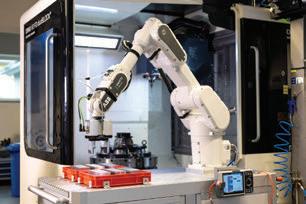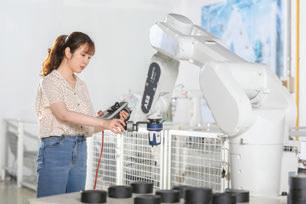
1 minute read
Industrial Collaborative Robot
Designed to bridge the gap between industrial and collaborative robots, ABB’s new Swifti CRB 1300, with a payload of up to 11kg, can be used in applications such as palletizing, pick-and-place, and screw driving.

User programming the Swifti CRB 1300 cobot. Source: ABB

Source: ABB
Powered by ABB’s OmniCore C90XT controller, the new Swifti CRB 1300 is up to five times more precise than any cobot in its class, according to ABB. Features include speeds up to 6.2m/s, payload options from 7kg to 11kg, and reaches from 0.9 to 1.4m. The robot also has protection against dust and moisture (up to IP67).
A key collaborative application feature of the Swifti is its use of a safety laser scanner integrated with ABB’s SafeMove collaborative safety software. This allows for safe collaborative use, eliminating the need for protective fencing or other physical barriers between humans and the robot. If the laser scanner detects a worker within Swifti’s operating area, ABB’s SafeMove software automatically slows the robot or stops it completely as needed. As the worker moves away, robot movement is restored, returning to full speed for full productivity only once the working area is completely clear. A built-in status light provides a visual indication of the cobot’s status when a worker is within the workspace area.
According to ABB, the Swifti CRB 1300 can improve production efficiency by up to 44% com- pared to other cobots in its class. For example, in a typical palletizing application, the Swifti can process up to 13 boxes per minute compared to the nine boxes possible with other cobots in its class.
Users can program the Swifti by physically guiding it through a process (lead-through programming) or by using ABB’s Wizard Easy Programming software, which uses graphical block programming to allow non-specialists to program the robot.




